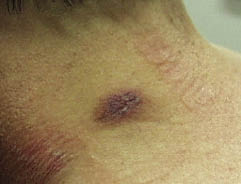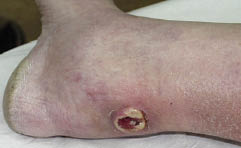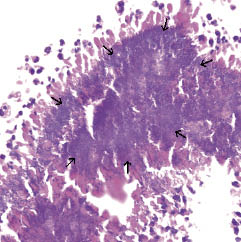Esben Techau Jörgensen
Department of Dermatology, Länssjukhuset, SE-391 85 Kalmar, Sweden. E-mail: esbenj@ltkalmar.se
Accepted April 18, 2006.
Sir,
Actinobacillus actinomycetemcomitans and Actinomyces spp. are commensal in the human mouth. They are in combination a rare cause of a variety of infections such as odontological infections, pneumonia, endocarditis, severe eye infection, and have been reported in traumatic skin ulcers (1–4). Multiple lesions of the skin caused by Actinobacillus and Actinomyces in combination without internal foci, has to the best of my knowledge not been described in the literature.
CASE REPORT
A 54-year-old woman, a smoker since 13 years of age and treated for chronic obstructive lung disease with budesonide and terbutaline, developed pneumonia-like symptoms after a dental extraction in December 2003; this was successfully treated with doxycycline.
In January 2004, the patient started to develop disseminated cutaneous infiltrates on a toe, the dorsum of one hand, arms, thighs, abdomen, neck and over one heel, a total of 11 lesions. The lesions started with a red, warm infiltrate (Fig. 1), later to become ulcerated leaving 3–5 cm diameter oozing ulcerations (Fig. 2)

Fig. 1. New infiltrate on the back of the neck.

Fig. 2. Two-week-old infiltrate on the heel.
The patient received treatment with clindamycin for 4 weeks with no effect. X-ray of the lungs and heart was normal. A skeletal scintigram showed no abnormalities. Bacterial swaps from ulcers were repeatedly negative. The sedimentation rate was 40 mm/h.
On referral to our clinic on 26 February 2004, 3 new lesions had developed within the last week. A biopsy was taken from a lesion on the thigh. This showed an intense inflammatory process with paniculitis and a congregation of Actinomyces-like bacterial structures in the infiltrate (Fig. 3).
Fig. 3. Biopsy showing Actinomyces-like structures (arrows) in haematoxylin-eosin (H&E) stain.

On 28 April 2004 the patient was referred to the department of infectious disease, with the question as to whether this could be disseminated actinomycosis. After ruling out this possibility, the patient was referred to the department of rheumatology. On suspicion of idiopathic paniculitis the patient was treated with prednisone 40 mg/day and later with colchicine, also without effect. The patient was at the same time given penicillin, on suspicion of actinomycosis; this had no effect on the lesions, but was continued for 2 months anyway.
On 10 June 2004, the patient was referred back to our clinic, and a sample taken using an anaerobic technique from a new lesion revealed A. actinomycetemcomitans. The strain was resistant to penicillin, but sensitive to ciprofloxacin. The patient was prescribed ciprofloxacin 500 mg twice daily. The lesions in the skin immediately started to improve, and the ulcerations healed as expected. After 4 weeks all lesions were cleared. B- neutrophils had fallen from 12.8 to 3.5 109/l (ref 1.80–6.7 109), P-CRP had fallen from 66 mg/l to 6 mg/l (normal < 5 mg/l). The treatment with ciprofloxacin was stopped, and the patient has been free of lesion since, 18 months after the last treatment.
DISCUSSION
Repeated attempts to isolate Actinomyces failed in this patient, despite prolonged culture for 3 weeks in anaerobic conditions. This is not uncommon. Efforts were made to try to demonstrate Actinobacillus in the biopsy material, but this was not possible; no other infiltrate than that first identified was found in the biopsy material. A. actinomycetemcomitans is a small Gram-negative rod and was not possible to identify in the biopsy material when it was reinvestigated after the bacteria had been identified in culture. Although only Actinomyces-like organisms were seen in the biopsy, the lack of response to penicillin and the immediate response to ciprofloxacin suggests that the main cause of disease in this case is the isolated strain of A. actinomycetemcomitans, perhaps in combination with the unidentified Actinomyces species.
REFERENCES
1. Binder MI, Chua J, Kaiser PK, Mehta N, Isada CM. Actinobacillus actinomycetemcomitans Endogenous Endophthalmitis. Scan J Infect Dis 2003; 35: 133–136.
2. Dommann SN, Widmer M, Dommann-Scherrer C, Bernasconi E, Burg G. Actinobacillus actinomycetemcomitans isolated from a mycetoma of the forearm. Hautarzt 1994; 45: 402–405.
3. Kuijper EJ, Wiggerts HO, Jonker GJ, Schaal KP, de Gans J. Disseminated actinomycosis due to Actinomyces meyeri and Actinobacillus actinomycetemcomitans. Scand J Infect Dis 1992; 24: 667–672.
4. Brown JR. Human actinomycosis. A study of 181 subjects. Hum Pathol 1973; 4: 319–330.
